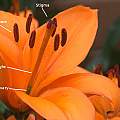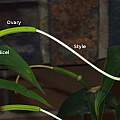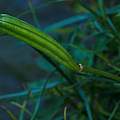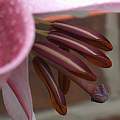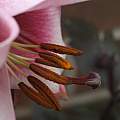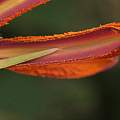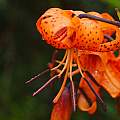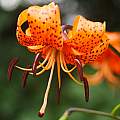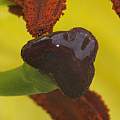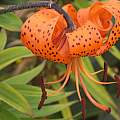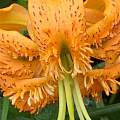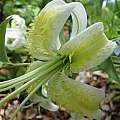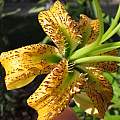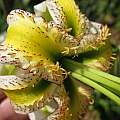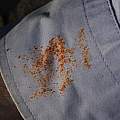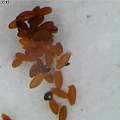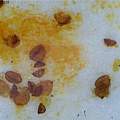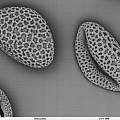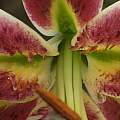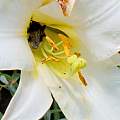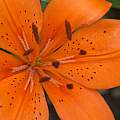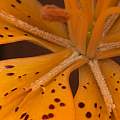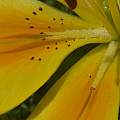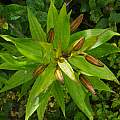Lilium is a large genus in the Liliaceae family. This page is devoted to lilium flowers. Photographs by David Pilling when not otherwise credited. For details of bulbs see Lilium bulbs. For seeds and propagation see Lilium seeds. For growing from seed see Lily Germination and Lily Germination By Species.
American Section A-M - American Section N-Z - Asiatic Section A-C - Asiatic Section D-K - Asiatic Section L-O - Asiatic Section P-Z - Candidum Section - Dauricum Section - Martagon Section - Oriental Section - Trumpet Section - Lilium Hybrids - Lilium Index
Lily flowers are constructed like the flowers of many other species, however hybrid lilies have such large flowers that it is easy to see how they work. A lily flower has three sepals, three petals, six filaments and anthers, and one three lobed stigma on a single style; the annotated photographs below show them. The relationship between the style and ovary is clearer after the petals detach as shown in photo four; the ovary eventually develops into the seed pod, see photo five.
As the flower opens, the anthers effectively turn inside out by opening (dehiscing), they then often rotate from parallel to the filament to being at right angles; making it more likely visiting insects will be coated with pollen. The first photograph shows the anthers beginning to open, the second shows them fully open revealing the pollen inside. The third photo shows how the filament attaches to the anther; the last two photos show another example of anthers before and after opening.
Lilium 'Chiara' anthers opening. Time lapse by David Pilling of anthers taken between 17:00 22nd July 2013 and 12:20 23rd July, temperature around 80 °F.
Lilium 'Leslie Woodriff' time lapse of flower opening by David Pilling taken between 18:49 23rd July 2013 and 03:48 24th July 2013.
Lilium 'Leslie Woodriff' time lapse by David Pilling, shows anthers opening and on the left hand side you can see nectar running down the flower. Taken between 11:53 24th July 2013 and 17:30 25th July 2013.
Lilium regale video of a perfect Summer afternoon, 3pm on the 27th July 2013 by David Pilling, bees pollinate Lilium regale.
Occasionally the stigma looks like it has been coated with black gloss paint, this is the result of stigmatic fluid, which is part of the pollination mechanism, ensuring the correct pollen is accepted.
So called 'Turk's Cap' lilies have recurved petals, although they look different to other lily flowers they are really the same as the photograph below of Lilium lancifolium caught opening demonstrates; the final photo shows how the flower looks fully open.
The bumps on the face of some lily flowers are called 'papillae', the first photograph shows an extreme example. Sometimes the presence of these bumps is used to distinguish different species. This feature has been exploited by lily breeders as photos 2-6 by Rimmer de Vries illustrate.
Pollen
Lilies produce large amounts of pollen. Since lily pollen is the natural enemy of soft furnishings and toxic to cats, it is surprising they are the world's most popular cut flower. The secret to removing pollen is to avoid crushing it; light flicking with a handkerchief, blowing, or dabbing with sticky tape works, rubbing leads to disaster. Many flower arrangers remove the anthers or stamens, which it is said has the effect of extending the life of the flower, presumably by preventing pollination. The second and third photographs of an area about 1 mm wide show Asiatic lily pollen and the stain resulting from crushing it. Finally there is a back-scattered electron microscope image of pollen grains from Lilium auratum by remf.dartmouth.edu (public domain).
Nectar
At the base of the petals are glands that secrete nectar (nectaries), a sticky viscous transparent fluid, as a treat for pollinating insects. The first photo shows nectar running from the centre of the flower and forming droplets (this lily was in a dry greenhouse and the liquid felt very different to water). The second shows a bee seeking out nectar. In some species (Asiatics) there is a hairy nectar tube which it is said is attractive to hummingbirds - examples are shown in the last three photos.
Phyllotaxis
Is a word which means "leaf arrangement" in Greek. One common scheme found in plants is for each leaf to be at 137.5° (the 'golden angle') to the next one on the stem, a possible motivation is that this angle maximises the light each leaf receives by avoiding being underneath another leaf. The photograph supports the idea that this is the arrangement of the leaves in lilies.
American Section A-M - American Section N-Z - Asiatic Section A-C - Asiatic Section D-K - Asiatic Section L-O - Asiatic Section P-Z - Candidum Section - Dauricum Section - Martagon Section - Oriental Section - Trumpet Section - Lilium Hybrids - Lilium Index


